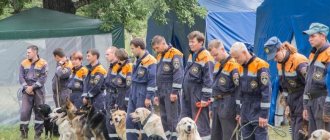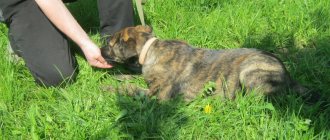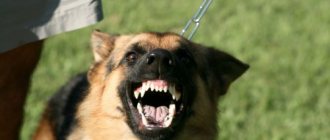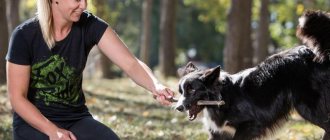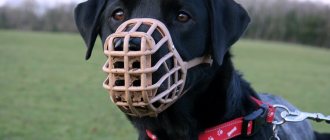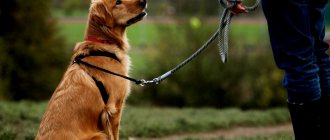The role of the prohibition command in training a dog
You can prohibit any unwanted action with a special command, most often it is “ugh!” The role of prohibitive treatment is very important, since the dog constantly commits some incorrect actions. Over time, a similar command can wean your pet from damaging property or other things.
At what age should you teach?
The “no” command for a puppy is difficult to understand, but it is recommended to start training from a very early age. This should be done outside the house and on a regular leash. You can start prohibiting before the age of 1 month.
Full training begins at the age of 3-4 months. Before this, it is not recommended to place much emphasis on education.
Actions must be consistent and predictable.
Basic rules of education
When training a German Shepherd, you need to follow certain rules.:
- The dog is first taught simpler commands and only later moves on to more difficult ones.
- At the beginning of training, it is recommended to reinforce any command with a nickname, which serves as a call for attention.
- All commands, with the exception of prohibiting ones, are pronounced in a neutral tone.
- Commands should not be distorted: for example, instead of “Come to me!” say “Come here!”
- It is necessary to be reasonable about rewards and punishments: do not use them excessively, but do not ignore them either.
- During classes, it is unacceptable to hit the dog or shout at it.
- During classes, commands should be alternated, and not constantly repeated.
Only one person should be involved in training a shepherd dog, whom the dog trusts and obeys unquestioningly..
The difference between the commands “fu” and “no”
Before you start training, you need to take into account that between the commands “no” and “fu!” there is a significant difference. A German Shepherd, Labrador or Rottweiler will react differently to them. "Ugh!" refers to a complete and categorical prohibition. This command is one of the very first that the pet begins to perceive.
Only used when the puppy performs unacceptable actions, for example:
- damage to furniture;
- aggression towards other animals;
- picks up trash on the street.
You need to teach your child through punishment in various ways. If you do it the same way, the pet will prepare for the expected punishment.
Note! The “no” command refers to a temporary prohibition. It can be canceled soon.
An example is when a puppy is not allowed to take a treat or eat. How to teach a dog the “no” command? The process is very lengthy, since training methods associated with punishment cannot be used.
The difference between "You can't" and "Ugh"
Both commands are prohibitive, but still have certain differences.
- “Fu” - more related to the educational process, does not entail any reward for execution.
They master it from a young age. The order requires a complete stop to unwanted actions: pampering, biting fingers, chewing shoes, etc. During the Skoda, they gently but strictly make it clear to the animal that something cannot be done. In this case, punishment is carried out exclusively at the time the crime is committed, and not after a long period of time. The order should sound as strictly and clearly as possible.
In such cases, the technique of distraction works well. For example, if an animal chews on slippers, the action is stopped with a ban and a click on the nose, the shoes are taken away, and a toy is offered in return.
- What does the “No” command mean?
A temporary injunction that is lifted by filing another order.
Age for learning the "fu" command
Improper upbringing from an early age becomes the reason why a dog begins to dominate and disobey. Therefore, teach the command “fu!” recommended from a very early age.
Experts advise against starting training before the age of 3 months. This is due to the fact that the nervous system should not be disrupted. It is recommended to start with the “give” lesson. It is suitable for the case when the dog has grabbed something and must give it back.
Principles of training a puppy
These prohibitions can be easily taught at home on your own. Some tips on how to teach your dog the “fu!” command:
- Misdemeanors should be punished immediately. If delayed, the dog will begin to avoid communication with the owner and will begin to perceive him as a threat;
- the command is pronounced only once, after which physical impact can be applied;
- the main condition is that the punishment be consistent. You cannot prohibit something and then allow it.
The team has to be trained over a long period of time, so you will have to immediately be patient.
Is it necessary to teach the command “Fu!” an adult dog?
If you adopted a mongrel from the street, or you received an untrained dog as an adult, it is definitely worth teaching it to perform the “fu” command. The training process can be quite complex, since you have to deal with an animal that has developed a certain model of behavior, has already formed a character, and has no genetic predisposition to training.
Despite this, work hard with your pet, because yard and abandoned dogs are far from both following commands and basic education - they can eat from the trash heap and show aggression towards animals. If difficulties arise, do not abandon your pet - dog handlers will definitely help you.
"No" command
This is a temporary disable command that can be overridden by a subsequent enable command.
Examples: you cannot approach someone, enter or exit, take a treat, or start a meal. The dog can perform all these actions only after a command-offer (“take”, “eat”, “on”, and so on).
Another important purpose of this prohibiting command is to train complete obedience. Complete discipline is achieved by instilling in the dog the uncharacteristic ability to suppress its first impulses. To do this, after a given command, for example, “fetch”, a prohibiting command “no” is given - immediately before the dog is ready to take the thrown object. Then, when the dog has stopped, the “fetch” command is given again, and the animal completes the initial task assigned to it.
It may seem to many that teaching a dog to stop an unwanted action with the command “Fu” is quite simple. However, this is not the case, and as practice shows, it is much easier to train a dog to do something on command than not to do something. The fact is that in the first case you show exactly what you want, while the second case is an abstraction, and dogs perceive abstraction very poorly. Therefore, to achieve perfect execution, you will have to work hard, but it is worth it. So, let's look at how to teach a dog the “Fu” command.
The “Fu” command is practiced through coercion or, to be more precise, punishment, since the impact on your part always comes after some action of the dog. Usually the “Fu” command begins to be used at a very early age, when the puppy is playing too much. At the same time, it is recommended to begin serious training from 6 months, when the pet learns the commands “Sit”, “Come to me” and learns to completely trust you. It is highly not recommended to put pressure on a puppy until it is six months old; just try to avoid situations that provoke your pet into non-forbidden actions. Since training the “Fu” command is based on punishment, it will not be able to bring joy to the dog, and if you go too far, your dog will simply break.
Also remember that even very well-trained dogs flawlessly execute the “Fu” command only when they begin to do something. If the dog is already fully engaged in an unwanted action, then it will be much more difficult to stop it. For example, if a dog takes leftovers in its mouth, then when it hears your exclamation, it will not spit out the food, but will try to swallow it quickly. Thus, you cannot delay giving the “Fu” command; this is one of the biggest mistakes.
Basic rules of training
When starting to train your pet with basic prohibition commands, you need to follow these rules:
- It is advisable to conduct training sessions with your dog outdoors. You should choose a secluded place where there are few distractions: cars, people, other animals. There is no need to remove plastic bottles and other garbage - it will be useful for training. Just make sure that there are no dangerous objects among the scattered objects.
- It is better to choose different places for training, then the dog will carry out the command anywhere after the end of training.
- During training, your dog should be wearing a leash and collar so that you can fully control him.
- When practicing the “Fu” and “No” skills, the animal is not rewarded. If the owner is satisfied with the training, he can give him a treat after training.
- If you forbid your pet to take any objects from the ground or pester people or other animals, always do this. You cannot first restrict a dog from certain behavior and then allow it. Then the commands will lose their meaning.
- If an animal starts playing and gets into a fight with another dog, you won’t be able to stop it with an order. It is necessary to force the dogs away or take away an unnecessary item from the pet.
- Do not use the same objects to practice the command “No” as for “Fu”. Otherwise, the puppy will not be able to perform any of these tasks correctly.
Amateurish teaching method
More suitable for working with puppies from three months to six months.
- Sit in front of the dog at some elevation.
- Hold a treat in your hand and attract your pet's attention.
- When the animal starts trying to scratch out the treat, they strictly say “No”.
- In case of disobedience, the palm is removed, and the pet is lightly clicked on the back of the nose or taken by the scruff of the neck, slightly lifted and then sharply lowered to the ground.
Important! Under no circumstances should the puppy be in pain, just unpleasant and a little offensive!
It is quite logical that even after such human actions, the baby will continue to persist. The owner must show restraint and stoically withstand the onslaught. They wait until the puppy gets tired of the “fight”, he stops to rest or loses interest in the treat. At the same moment they say the command “It’s possible” and give the tasty treat.
The number of repetitions is no more than three times a day with long time intervals.
In the future, the task becomes more complicated:
- the palm with the treat is kept open, closed only if the pet does not follow the order;
- the treat is placed on the floor;
- They randomly mix the commands “It’s possible” and “It’s not possible.”
How to teach a dog the “fu” command step by step
Teaching a puppy the “Fu” command is quite difficult, so if you are currently busy practicing some other command, you should finish it first. Also, if you have started learning the “Fu” command and have not yet completed all its stages, you should not start learning other exercises.
Stage 1: Basics of the "fu" command
It is recommended to start training outside the home and on a regular leash. For training, choose a calm route where there will be no too strong stimuli, but there will be forbidden objects, such as scraps or pigeons. When training professional dogs, trainers specifically place prohibited objects along the dog’s path. If you wish, you can take a partner with you and ask him to place sausages or pieces of sausage in the path without the dog noticing. As with practicing other commands, when learning “Fu” it is recommended to change routes as often as possible. Please note that for now there is no need to practice the “Fu” command for direct contact with other dogs or people; you will do this later.
When the route is chosen and everything is prepared, walk along it with the dog at a slower than average speed. You need to walk slowly so that both you and the dog have time to react to changing situations. When a dog, walking on a slack leash, heads towards a prohibited object (for example, a sausage left in advance), strictly say “Ugh” and then give a sharp tug on the leash. But balance the force of the pull with the size of your dog. At the same time, continue moving, the dog should be distracted for a moment, and then immediately resume moving behind you. After walking 2-3 steps, stop and give the dog a command, for example, “Sit” , and then give him a treat. This is necessary so that the dog is distracted and relaxed, since sudden braking and your influence is a strong stress for him. Keep in mind that it is strictly prohibited to directly reward the execution of the “Fu” command!
During training, it is better not to give the “Fu” command more than 5 times per walk, and the interval between commands should be about 15 minutes (so that the dog has time to calm down). The command must be given strictly, but calmly and without threat. In the first stages of training, do not yell at the animal under any circumstances; if the dog does not listen, use a leash. You can shout and bark at your pet only later, in cases where he does something completely unacceptable, and when he has already learned what actions are prohibited. If the dog has learned the “Fu” command, but does not respond to it at your first word, then you can bark again.
If you have prohibited some action, for example, sniffing a pole, then under no circumstances allow this action after executing the command. You can let me sniff the next pillar, but not this one. Remember that the “Fu” command is a complete ban, not a brake. Never use the "Fu" command if the situation requires a different command. For example, if the dog grabbed your hat and does not give it back, say “Give” , if the dog is pulling on the leash, command “Near” , if the dog left by the backpack decides to stand up, say “Wait” .
Some ill-mannered dogs react poorly to a tug on the leash; it does not stop them. What to do then? If the dog is a large breed, such as a German Shepherd, then to teach it to the “Fu” command, use a strict or electronic collar. You can also use rolled up newspaper. If the dog does not respond to the tug, slap him on the butt or neck with a newspaper. This almost always stops the unwanted behavior. Just don’t forget about the sequence: first the voice command “Ugh!”, then a jerk with the leash, and only then the newspaper. If the dog reacts to the voice, then there is no need to pull the leash. If you react to the leash, put the newspaper aside until next time.
Stage 2: honing the skill
When the pet begins to obey the command well, begin to complicate the conditions. Now practice the “Foo” command in busy places, in contact with other dogs or people. The skill can be considered mastered when the dog stops any unwanted behavior at your first command. Only after this can you start practicing the “Fu” command at a distance and using a long leash. In this case, you lose the opportunity to influence the newspaper, which is why you first need to train on a short leash.
How to train a dog to refuse random food?
The need for such behavior is determined by the fact that the dog can pick up poisoned food planted by ill-wishers. Therefore, it is necessary to develop inhibition of the food reaction in her.
Training should be done between regular feeding hours. First you need to teach your dog not to eat in inappropriate places. To do this, the feeder is placed in a different place and, if the dog tries to eat from it, this is stopped by the command “fu” and tugging on the leash. You can also train endurance by constantly keeping food somewhere nearby. Every unnecessary movement towards food is stopped by the command “fu” and “sit”, as well as a sharp jerk of the leash. If the dog obeys, you definitely need to reward it with some kind of treat or put the feeder in its usual place and feed it.
The next stage is the ban on accepting food from strangers. The owner must keep the dog on a short leash while walking. Another person, prepared in advance for such manipulations, should pass by with a treat in his hand and offer it to her. If the dog reaches for food, the owner should command “fu” and pull the leash.
When a stranger scatters food around the territory, the procedure is repeated. When a dog is too greedy for food, the owner should hit it on the backside and another person should spank it on the face with a hand containing a treat. If she remains calm and does not pay attention to the food, then the owner should encourage her with his own hand.
All training methods are individual, only the owner knows exactly how to approach his four-legged friend! Take care of animals and love them with all your heart!
Ways of learning
These methods are based on positive reinforcement and are equally suitable for both a puppy and an adult dog.
Method 1
- Prepare 2 types of treats: one delicious, the other even tastier. Think about which treats your pet likes the most and which ones a little less.
It is important to choose something that the dog still likes as a less tasty treat, otherwise it will be of no use.
- Take your pet on a leash (preferably with a harness) or find an assistant who can hide food from the dog at the right time.
- Show the animal that you have food and place a piece of a less tasty treat on the floor. Don't let your dog grab the treat (use a leash or have a helper close the treat). At first, the pet will try in every possible way to get close to the treat - ignore this behavior. As soon as you see that the dog has been distracted from its goal for a second (turned around, looked at another point or at you), immediately feed your pet a more tasty treat from your hands. Repeat this several times until the dog understands that trying to get food from the floor will not bring him anything good, and distraction from the treat on the ground, on the contrary, entails encouragement from the trainer.
- Gradually, you can increase the criteria. Now you need the dog to be distracted from food in your direction. As soon as your pet is distracted from food and looks at you (ideally in the eyes), give him a tasty treat from your hands.
- If the previous steps are completed successfully and the dog understands the task, enter the voice command “fu”.
- Practice the exercise without a leash and an assistant. You can use other treats and practice the skill in different environments.
Method 2
- Take a treat and hold it in your fist. First, let your dog sniff the treat without giving it away.
- Squat down in front of your dog, holding your fist at the level of his nose. The dog will try to get food by licking his fist. Perhaps your pet may start barking. At this point, your job is to wait and monitor the behavior you want. The desired behavior means distracting the dog from the fist with food. As soon as the dog turns away, sniffs the ground or begins to do any other actions, distracted from the treat, immediately open your palm and praise the pet. Repeat this several times until the animal understands what is required of it. You must explain to the dog that he will receive a treat only at the moment when he does not look at your fist in which the treat is clutched.
- Gradually increase the criteria. Make sure that the dog does not look at a specific object other than a fist, but at you. Encourage all eye contact. Give your dog a chance to think and wait for him to look you in the eye. As soon as you catch her eye, praise her. After several such attempts, increase the duration of the gaze. First treat your pet after a second of eye contact, gradually moving to two, three, four or more seconds.
- Just don’t overdo it and don’t make the activity too monotonous and boring.
- Once your pet has mastered the skill well, enter the voice command “fu”. Ultimately, you will come to the point that a pet that sees forbidden food will not try to eat it, but rather will turn to you in anticipation of praise.
Training scheme
There are several methods for teaching a dog the “No” command. Which one to use depends on the type of nervous activity of the pet and its age. Let's consider a technique widely used in the training practice of service dog breeding.
The initial skill is developed in a place where there is a small number of distracting stimuli to which the pet actively and even violently reacts.
Approximate operating procedure:
- The dog is allowed to walk, while being kept on a short leash.
- The person carefully monitors the behavior of the animal, without interfering with its movement in any direction.
- As soon as the dog decides to grab something or rush towards the irritant, the owner immediately loudly and threateningly gives the command “No” and sharply tears the leash.
- If the animal stops and obeys, then it is encouraged (a treat, an approving pat, verbal praise) and continues walking.
Pulling back with the simultaneous issuance of a prohibiting order is carried out no more than twice during one walk.
The command can and should be practiced in parallel with training other skills. The operation scheme is identical to that described above.
After some time, when the conditioned reflex to the prohibition is developed and consolidated, it is necessary to complicate the task and conduct lessons in the presence of more distractions (near the roadway, in a forest belt, park, etc.) and on a long leash. You can release an animal from its leash only if it has already learned to obey unquestioningly without coercion.
In the case when the barboskin does not react at all to jerks and continues to go about its business, a more noticeable tugging, parfos or electric collar is used. But you need to know when to stop so as not to end up scaring or embittering your pet.
The skill is considered formed when the animal obeys the first time.
What not to do during training
By making a number of mistakes, you can negate all the progress in teaching your dog the “Fu!” command. But, as the Latin wisdom says: “Forewarned is forearmed,” so let’s look at the most common mistakes.
- You cannot teach a puppy the command “Fu!” in parallel with the execution of another command. This is a difficult skill that your pet needs to fully focus on. Also, don’t stop learning the “Fu!” command without going through all the stages and do other exercises.
- While practicing the command, watch how fast you are going. If you are distracted, you can speed up your pace too much, and it will be more difficult to control your dog’s behavior. It will also be more difficult for a four-legged friend to understand what they want from him.
- During the training process, take breaks; it is enough to repeat the command once every 10 minutes.
- It is important to remember that the command “Fu!” means a complete and permanent ban, and not a call to slow down. Do not use it when another command is required. For example, if your pet does not give you a shoe, command “Give!”; When the dog pulls on the leash, say “Here!”
- Another typical mistake is the belated issuance of the “Fu!” command. When an animal is completely carried away by prohibited actions, stopping it only with the help of a command will be problematic. So, having commanded “Fu!” in the midst of a dog fight, you will achieve nothing but a decrease in your own authority - the dogs need to be pulled apart.
- Do not overuse the “Ugh!” command. It serves to prohibit unwanted behavior at a specific point in time. Beginning dog breeders often try to prohibit all actions that they consider potentially harmful or dangerous, even sniffing a bench.
- Don't jerk the leash too hard without good reason. You should not yell at or hit your pet. This can harm the animal's psyche, and you will lose contact with it.
Attention! Training rules
- Do not use unnecessarily strong influences (jerk jerks, hits), especially at first.
- Always take breaks during the training process.
- Remember that you cannot first prohibit your dog from performing any action, and then immediately allow it a second later.
- Do not use the "Fu" command if another command can be used in this situation.
- Give the command in the first second, and not when the dog has already completely switched to the prohibited activity.
- Repeat the training periodically, as the skill is forgotten very quickly.
- Don't abuse the command or use it too often. A typical mistake is an attempt to prohibit not only undesirable actions at the moment, but also all actions that inspire fear that they may turn into such.
General training course
Tips from dog handlers
If you are unable to train your pet on your own, contact a specialist, but do not give up training. Classes with a dog handler will help correct the dog’s behavior. You might find some professional advice helpful.
The dog does not react to the tug of the leash - what to do?
While teaching the command “Fu!” the dog may not react to the tug of the leash and, accordingly, it does not stop it, which is why all the owner’s efforts go down the drain. This usually applies to large and giant breeds of dogs - Great Dane, Newfoundland, Bobtail. In this case, you can use a special metal collar with spikes or a harness that runs on microcurrents. A smack with a newspaper will also be effective.
The main thing is to always follow the sequence: the command “Fu!” – a jerk of the leash – a slap with a newspaper. If a strict collar disciplines the dog while tugging on the leash, then there is no need to use the newspaper.
If the puppy shows disobedience and there is no way to influence it with a leash, lift the pet by the collar and shake it slightly, then place it on the ground, pressing on the shoulder blades. This will show your dominance.
Possible mistakes
- The use of painful stimuli beyond measure: blows, a strict collar - all this will lead to general inhibition, suppression of useful reflexes and complete refusal to work.
- Inhibitions that are given too often without the use of an unconditioned stimulus (pulling) lose their warning value for the dog.
- Using a command inappropriately and inappropriately will also lead to the fading of the skill.
Often similar prohibiting commands “Ugh!” and “You can’t!” confused, but they have differences. You can not do it this way!" - a temporary ban that is used when practicing endurance as part of honing a dog’s obedience.
This command is pronounced at the moment when the pet is pulled by the collar, the leash is jerked, objects are thrown towards the dog, and rewards follow for correctly performed actions. The pet is forced to obey the command “No!”, thereby overcoming discomfort or pain.
What should a shepherd puppy be able to do before starting OKD training?
What techniques should you pay close attention to when training German Shepherd puppies, while the principle of learning fits into the rule: “Play and educate - teach and play”?
The obedience course is based on the same 5 basic commands that the puppy BUT has already learned in the first six months to a year of his life:
- "Sit!";
- "To me!";
- "Near!";
- "Voice!";
- “Aport!”;
This is the basis of all subsequent training, its foundation. Any German Shepherd puppy should know these commands and therefore it is advisable to teach the puppy these commands before the age of 1 year.
After mastering them, a more detailed elaboration of the techniques already in the arsenal begins and combination with more complex skills: fetching at a distance, jumping, sampling (search for things by smell), taking a trail, “Sit!” and “Lie down!” in motion, commands: “Wait!” and “Guard!”, slowing down and accelerating movement at the will of the owner when he himself stands still, as well as familiarization with complex special training techniques - the initial training: “Fast!” and “Take!”
How to teach a shepherd to eat on command
Painful questions for many German Shepherd owners.
It is not difficult to teach a puppy to eat on command from the age of 4-5 months. It is enough to click him on the nose several times after the command: “You can’t!” or completely remove the bowl from under the nose, forcing him to wait for the permissive command: “Eat!”, and the baby will learn to sit at the bowl waiting for permission. The giver of blessings in the house is the leader-owner.
Use the command: “Ugh!” in this case - a grave mistake!
This command obliges the shepherd to refuse all further actions, and therefore the opportunity to eat. Don’t confuse the puppy, you can eat, you just need to wait for your permission.


